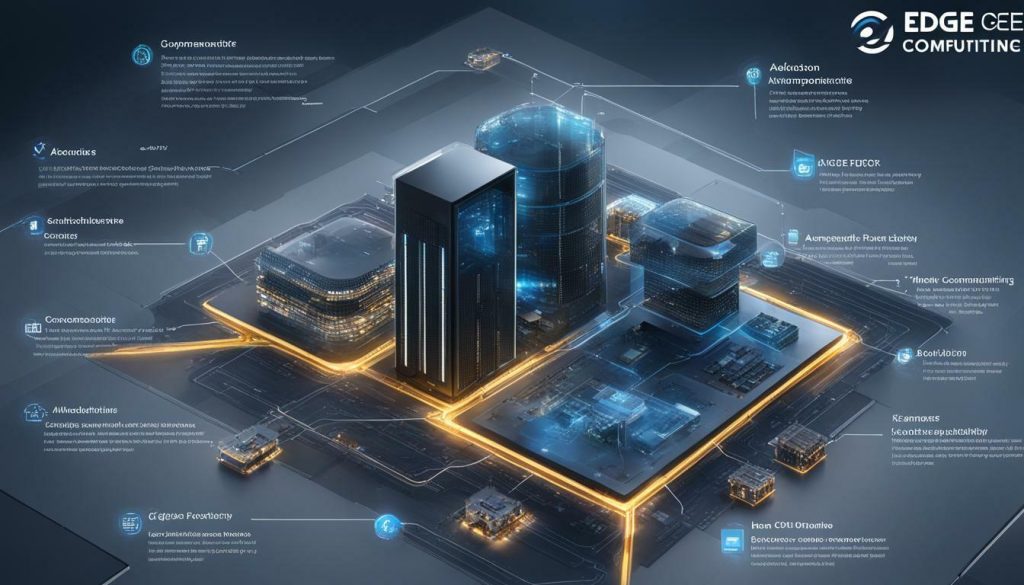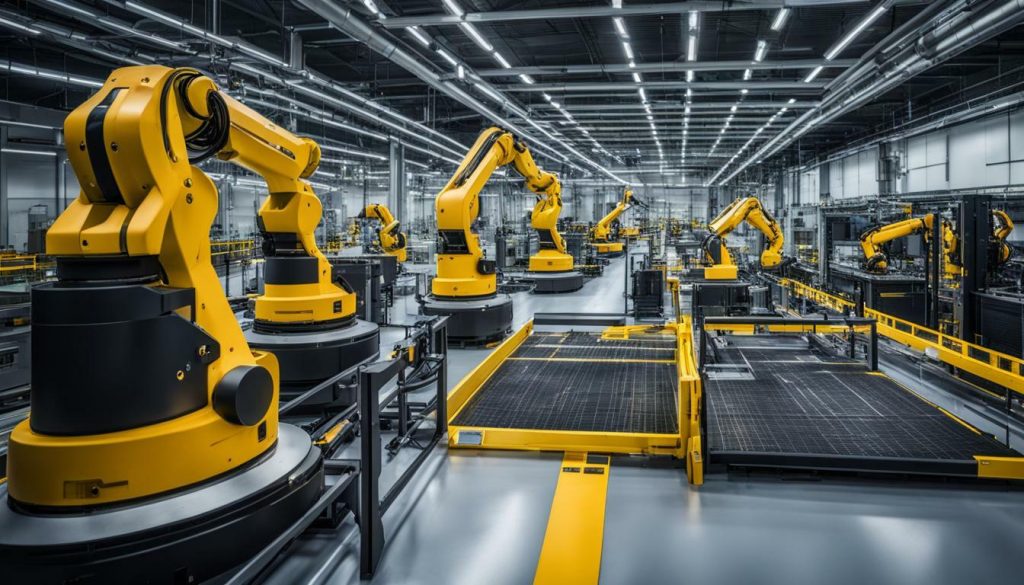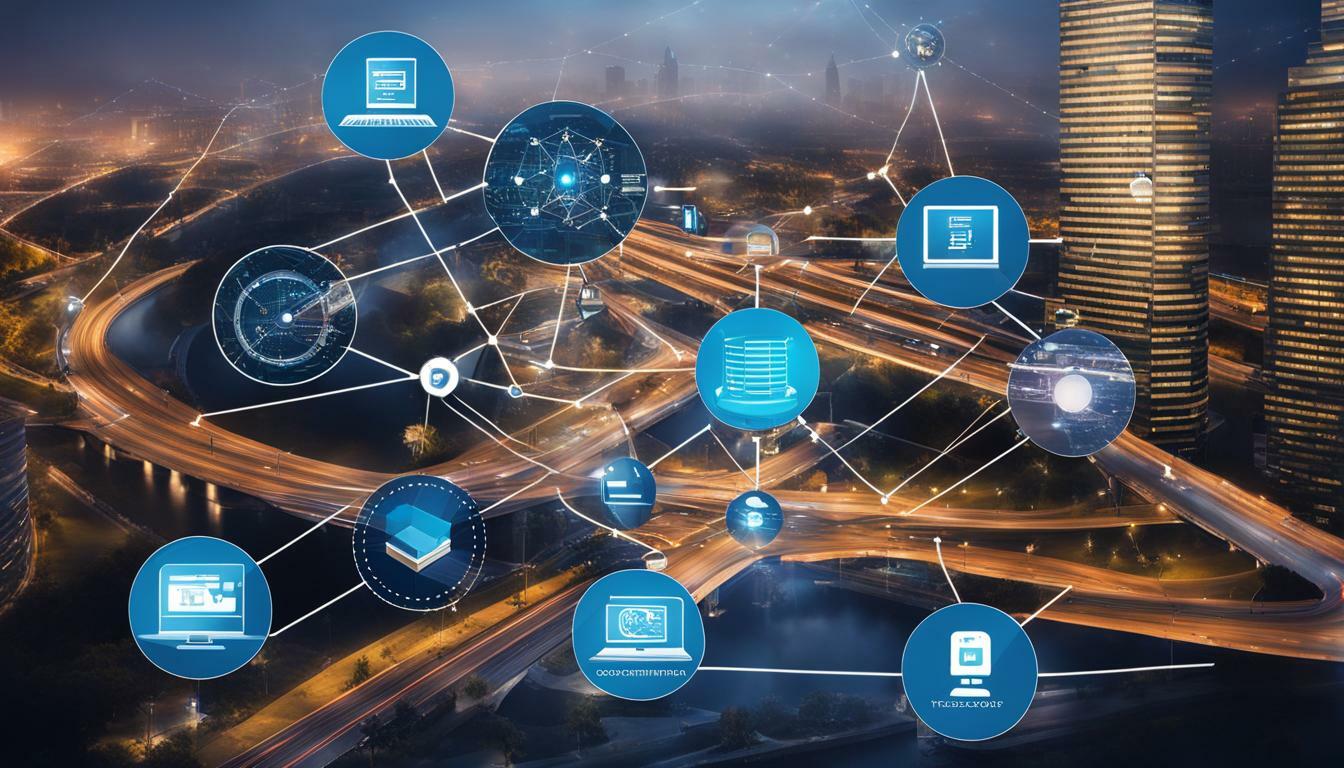Edge computing use cases are revolutionizing how data is processed and analyzed by bringing computation closer to the source, enabling organizations to unlock its potential in various industries.
As organizations seek to leverage the benefits of edge computing, it is important to explore real-world applications and understand how this technology is transforming various sectors.
- Edge computing technology is gaining traction in industries like autonomous vehicles, smart cities, healthcare, manufacturing, and more.
- By processing data closer to the source, edge computing allows for real-time analysis and processing, reduces latency, improves security, and enables efficient handling of large volumes of data.
- Organizations can benefit from edge computing in terms of enhanced workplace safety, streaming services and content delivery, enhanced customer services, and smart home innovations.
- The Eclipse Foundation reports that 54% of organizations are already using or planning to use edge computing technologies.
- Edge computing offers a decentralized approach to data processing, providing faster response times and improved overall system performance.
Understanding Edge Computing Technology
Edge computing technology refers to the decentralized approach of processing and analyzing data at or near the source, rather than relying on a centralized cloud infrastructure. This approach brings computing capabilities closer to the edge of the network, enabling faster data analysis, lower latency, and improved overall performance.
Unlike traditional cloud computing, which relies on sending data to a centralized location for processing, edge computing distributes the processing power to devices and systems at the network edge. This enables real-time decision-making and reduces the need for constantly transmitting large amounts of data to and from the cloud.
One of the key components of edge computing architecture is distributed analytics. With distributed analytics, data processing is performed locally, allowing for faster insights and immediate responses. By analyzing data at the edge, organizations can extract valuable insights in real-time and make informed decisions without relying solely on the cloud.

Edge computing architecture employs a combination of edge nodes and gateways that act as intermediaries between devices and the cloud. These edge nodes are equipped with computing power and storage capabilities, enabling them to process data locally. Gateways, on the other hand, aggregate and relay data from multiple devices to the edge nodes or the cloud.
In summary, edge computing technology revolutionizes the way data is processed and analyzed, bringing computational capabilities closer to the source. By leveraging edge computing architecture and distributed analytics, organizations can unlock the full potential of their data, enabling faster decision-making, lower latency, and enhanced overall performance.
Table 1: Key Components of Edge Computing Architecture
| Edge Nodes | Gateways |
|---|---|
| Equipped with computing power and storage capabilities | Aggregate and relay data from multiple devices |
| Process data locally | Connect edge nodes to the cloud |
| Enable real-time decision-making | Act as intermediaries between devices and the cloud |
Benefits of Edge Computing
Edge computing offers a multitude of benefits, from enabling real-time data processing to supporting low-latency applications that require near-instantaneous response times.
With traditional cloud computing, data is sent to a central server for processing, which can introduce delays and increase network congestion. However, edge computing takes a different approach by processing data closer to the edge of the network, where it is generated. This allows for faster analysis and decision-making, making it ideal for time-sensitive applications.
One of the key advantages of edge computing is its ability to handle real-time data processing. By processing data at the edge of the network, organizations can analyze and respond to data in real-time, enabling faster insights and decision-making. This is particularly valuable in industries such as healthcare, where real-time data processing can help monitor patients’ vital signs and detect anomalies or in manufacturing, where it can enable predictive maintenance to prevent equipment failures.
Another benefit of edge computing is its support for low-latency applications. With edge computing technology, data is processed locally, reducing the time it takes for data to travel back and forth from cloud servers. This is crucial for applications that require near-instantaneous response times, such as autonomous vehicles and augmented reality experiences.
By minimizing latency, edge computing enables smoother, more immersive user experiences and enhances overall system performance.

Edge computing also offers improved security by reducing the attack surface and potential risks associated with transmitting sensitive data over long distances. By processing data locally, organizations can isolate critical information and minimize the exposure of sensitive data to potential threats. This is particularly important in industries that handle sensitive information, such as financial services and healthcare.
In summary, edge computing brings numerous benefits to various industries by enabling real-time data processing, supporting low-latency applications, and improving security.
Its ability to process data closer to the edge of the network offers faster insights, enhanced user experiences, and more efficient handling of large volumes of data. As organizations continue to adopt edge computing technologies, we can expect to see further advancements and innovative use cases in the future.
Edge Computing in the Internet of Things (IoT)
Edge computing plays a crucial role in the IoT ecosystem, allowing for efficient data processing, analysis, and decision-making at the edge of the network, closer to IoT devices and sensors.
With the exponential growth of connected devices and the increasing demand for real-time data insights, traditional cloud computing architectures face challenges in terms of latency, bandwidth, and security. Edge computing addresses these limitations by bringing data processing closer to the source, enabling faster response times and reduced reliance on central cloud servers.
In the context of IoT infrastructure, edge computing offers several benefits. By processing data at the edge, organizations can reduce data transmission and storage costs. It also enables real-time analytics, enabling faster insights and timely decision-making. Additionally, edge computing enhances security by minimizing data exposure and reducing the risk of unauthorized access to sensitive information.
One of the key applications of edge computing in IoT is remote monitoring. With edge devices deployed closer to IoT devices and sensors, organizations can monitor and analyze data in real-time, allowing for proactive maintenance and optimizing operational efficiency. Remote monitoring enables organizations to identify anomalies, predict failures, and take corrective actions promptly, preventing costly downtime and enhancing overall productivity.
| Benefits of Edge Computing in IoT |
|---|
| 1. Reduced latency |
| 2. Real-time analytics |
| 3. Enhanced security |
| 4. Cost savings on data transmission and storage |
| 5. Proactive maintenance and operational efficiency optimization |
Edge computing, in conjunction with IoT, is revolutionizing industries such as healthcare, manufacturing, transportation, and smart cities. The ability to process data closer to the source enables organizations to unlock valuable insights, improve operational efficiency, and drive innovation.
As the number of connected devices continues to grow, edge computing will play a pivotal role in shaping the future of IoT, providing the necessary infrastructure to handle the massive volumes of data generated by these devices.

“Edge computing brings the power of cloud computing closer to the edge of the network, enabling real-time insights and faster decision-making in IoT applications.”
In summary, edge computing is a game-changer for the IoT landscape. By processing data at the network’s edge, organizations can leverage its benefits to achieve reduced latency, real-time analytics, enhanced security, cost savings, and proactive maintenance. With the rapid growth of IoT devices, edge computing is poised to become an integral part of IoT infrastructure, empowering organizations to extract maximum value from their data and drive digital transformation.
Edge Computing for Smart Cities
Edge computing is revolutionizing the concept of smart cities, empowering them to utilize real-time data processing for improved workplace safety and efficient management of urban systems. By deploying edge computing technologies at the network edge, cities can collect and analyze data from various sources in real-time, enabling timely decision-making and proactive response to critical situations.
In a smart city setting, edge computing offers numerous benefits. It enables the integration of data from sensors, cameras, and other IoT devices, allowing cities to monitor traffic flow, air quality, and energy consumption in real-time. This data can then be analyzed and acted upon immediately, optimizing resource allocation and reducing pollution levels.
Additionally, edge computing enhances workplace safety by enabling real-time video analytics for detecting and responding to security threats. By processing video feeds locally, edge devices can identify potential safety hazards, such as unauthorized access or suspicious behavior, and trigger immediate alerts for rapid intervention.
With the implementation of edge computing, smart cities are transforming into connected, data-driven urban landscapes, where real-time data analysis and decision-making are driving efficiency, sustainability, and enhanced quality of life for citizens.
Enhanced Workplace Safety with Edge Computing
“Edge computing allows us to monitor critical areas of the city in real-time, enabling immediate response to safety incidents. By processing video feeds locally, we can detect potential threats and dispatch emergency services promptly, ensuring the well-being of our citizens.”
Smart cities have witnessed significant improvements in workplace safety through the adoption of edge computing. By leveraging edge devices equipped with AI capabilities, cities can analyze video feeds from surveillance cameras in real-time, detecting and responding to safety incidents more efficiently. This proactive approach to workplace safety reduces the time it takes to address potential risks, minimizing the impact on public safety.
The introduction of edge computing technology has a transformative effect on the way cities manage their infrastructure and ensure the well-being of their citizens. By harnessing real-time data processing at the network edge, smart cities can continue to evolve and thrive, creating more sustainable, secure, and efficient urban environments.

| Benefits of Edge Computing for Smart Cities | Examples |
|---|---|
| Real-time data processing | Real-time traffic monitoring and optimization |
| Enhanced workplace safety | Real-time video analytics for detecting and responding to security threats |
| Efficient management of urban systems | Monitoring and optimization of energy consumption |
By capitalizing on the benefits of edge computing, smart cities can unlock new possibilities for innovation, sustainability, and improved quality of life. As technology continues to advance, the adoption of edge computing in smart cities is set to accelerate, creating a future where data-driven decision-making and real-time insights drive urban development and transform the way cities operate.
Autonomous Vehicles and Edge Computing
Edge computing plays a pivotal role in the advancement of autonomous vehicles, facilitating real-time data processing and intelligent decision-making on board. With the rise of autonomous vehicles, the need for immediate and accurate data analysis is crucial to ensure safe and efficient operations. Edge computing technology brings processing power closer to the source, enabling vehicles to analyze data locally without relying solely on cloud computing.
By utilizing edge computing, autonomous vehicles can process data from various sensors, including cameras, lidar, and radar, in real-time. This allows for quick detection of obstacles, pedestrians, and other vehicles, contributing to improved safety on the roads. Efficient data processing also enables autonomous vehicles to make split-second decisions, such as adjusting speed or changing lanes, without relying on distant cloud servers.
Furthermore, edge computing helps overcome challenges related to low-latency communication. Autonomous vehicles require fast response times to navigate complex environments and react to changing road conditions.
By leveraging edge computing, these vehicles can perform real-time data analysis onboard, reducing the reliance on cloud connectivity and minimizing latency. This ensures that critical decisions can be made instantaneously, enhancing the overall performance and reliability of autonomous vehicles.

- Real-time data processing and analysis for immediate decision-making
- Reduced reliance on cloud connectivity and minimized latency
- Enhanced safety through quick detection of obstacles and other vehicles
- Improved performance and reliability of autonomous vehicles
“Edge computing brings processing power closer to the source, enabling autonomous vehicles to analyze data locally without relying solely on cloud computing.”
As autonomous vehicles continue to evolve, edge computing will play a crucial role in enabling their capabilities. The integration of edge computing technology empowers these vehicles to process data on the edge of the network, ensuring real-time decision-making and enhancing overall performance. With the advantages it offers, it is clear that edge computing has a significant impact on the advancement of autonomous vehicles and the future of transportation.
Edge Computing for Industrial IoT
Edge computing is transforming the industrial landscape, empowering organizations to harness the power of real-time data analysis to optimize processes, improve productivity, and reduce downtime. In the realm of Industrial IoT (IIoT), edge computing solutions play a crucial role in enabling efficient and intelligent operations.
By bringing computing power closer to the edge of the network, edge computing solutions facilitate real-time data processing and analysis, allowing industrial systems to respond swiftly to changing conditions. This immediate access to insights enables predictive maintenance, enabling organizations to identify potential equipment failures in advance and take proactive measures to prevent costly breakdowns.
The ability to process data at the edge also reduces latency, ensuring that critical data is transmitted and acted upon in near real-time. This is especially important in industrial settings where time-sensitive decisions need to be made rapidly. Edge computing solutions enable faster response times, leading to improved operational efficiency and enhanced productivity.
Moreover, the large volumes of data generated by industrial IoT devices can be overwhelming to centrally located cloud servers. Edge computing solutions offer a distributed architecture, allowing data to be processed and analyzed locally before being sent to the cloud for storage or further analysis. This not only reduces the strain on the cloud infrastructure but also minimizes bandwidth requirements and ensures the privacy and security of sensitive data.
Edge Computing Benefits for Industrial IoT:
- Real-time data analysis: Instant access to actionable insights for agile decision-making.
- Reduced latency: Faster response times for time-sensitive operations.
- Predictive maintenance: Early identification of potential equipment failures to prevent downtime.
- Enhanced security: Local data processing ensures sensitive information remains secure.
- Improved operational efficiency: Streamlined processes and increased productivity.
The integration of edge computing solutions in the industrial IoT landscape enables organizations to unlock the full potential of their data, driving innovation, and achieving optimal performance. With the power of real-time data analysis at their fingertips, industrial players can stay ahead of the competition, maximize operational efficiency, and pave the way for a more connected and intelligent future.

Edge Computing in Cloud Gaming
Edge computing is revolutionizing the world of cloud gaming, allowing for immersive, low-latency gaming experiences that rival traditional console and PC gaming. With edge computing solutions, gamers can enjoy smooth gameplay, minimal lag, and real-time interactions, creating a more seamless and responsive gaming environment.
By processing game data closer to the edge of the network, edge computing reduces latency, which is crucial for cloud gaming. It enables real-time rendering and processing of graphics-intensive content, ensuring that gamers can enjoy high-quality visuals without any noticeable delays. This technology also minimizes the distance that data needs to travel, resulting in faster response times and improved overall performance.
One of the key advantages of edge computing in cloud gaming is its ability to bring the gaming infrastructure closer to the players. This eliminates the need for gamers to rely solely on their local device’s processing power, as much of the computationally intensive tasks are offloaded to edge servers. As a result, even older or less powerful devices can deliver an exceptional gaming experience.
| Benefits of Edge Computing in Cloud Gaming |
|---|
| 1. Low-latency gameplay |
| 2. Real-time rendering and processing of graphics |
| 3. Improved overall performance |
| 4. Accessibility on various devices |
Moreover, edge computing in cloud gaming allows for seamless scalability. With the ability to distribute game processing across multiple edge locations, game developers and providers can easily accommodate a growing user base without compromising performance. This scalability makes cloud gaming accessible to a wider audience and opens up opportunities for new gaming experiences.

As the demand for cloud gaming continues to rise, edge computing solutions are becoming increasingly crucial for delivering an optimal gaming experience. With its low-latency capabilities, real-time processing, and enhanced scalability, edge computing is transforming the landscape of cloud gaming, bringing gamers closer to their virtual worlds than ever before.
Edge Computing’s Impact on Digital Landscapes
Edge computing is transforming digital landscapes across industries, revolutionizing customer experiences, enabling seamless content delivery, and revolutionizing the concept of smart homes.
As organizations continue to explore edge computing use cases and examples, it is clear that this technology has the potential to revolutionize the way we interact with digital systems, from customer services and content delivery to smart homes and beyond.
Stay informed and inspired with our blog! Explore fascinating topics at the intersection of health and technology, fueling your curiosity for a healthier, tech-savvy future.
FAQ
Q: What is edge computing?
A: Edge computing refers to the practice of processing data closer to the source, rather than relying solely on a centralized cloud infrastructure. It enables real-time analysis and processing, reduces latency, improves security, and efficiently handles large volumes of data.
Q: Why are organizations adopting edge computing?
A: Organizations are adopting edge computing technology to leverage its benefits in various industries. Edge computing allows for faster processing of data, enhances security, improves performance, and enables real-time decision-making, making it ideal for use cases like autonomous vehicles, smart cities, healthcare, manufacturing, virtual and augmented reality, streaming services, and smart homes.
Q: How does edge computing differ from traditional cloud computing?
A: Edge computing differs from traditional cloud computing by processing data closer to the edge of the network, where the data is generated. This reduces the need for sending all the data to a centralized cloud infrastructure, resulting in lower latency and faster processing times.
Q: What are the benefits of edge computing?
A: Edge computing offers several benefits, including real-time data processing, reduced latency for time-sensitive applications, enhanced security, efficient handling of large volumes of data, improved performance, and increased overall efficiency of digital systems.
Q: How is edge computing applied in the Internet of Things (IoT)?
A: Edge computing plays a crucial role in the Internet of Things (IoT) by enabling distributed analytics and processing closer to IoT devices. This enhances IoT infrastructure, enables remote monitoring and control, and facilitates real-time decision-making for interconnected devices.
Q: What are some applications of edge computing in smart cities?
A: Edge computing technology contributes to the development of smart cities by enhancing workplace safety, improving urban infrastructure efficiency, optimizing traffic management, enabling real-time monitoring of utilities, and facilitating intelligent waste management systems.
Q: How does edge computing benefit autonomous vehicles?
A: Edge computing enables real-time data analysis and decision-making for autonomous vehicles, enhancing their safety and performance. It allows for faster processing of sensor data, enabling quick responses to changing road conditions and reducing the reliance on external networks.
Q: What is the impact of edge computing on industrial IoT?
A: Edge computing plays a critical role in the Industrial Internet of Things (IIoT) by providing real-time analytics and optimization for industrial processes. It enables predictive maintenance, enhances operational efficiency, and facilitates remote monitoring and control of industrial equipment.
Q: How does edge computing enhance cloud gaming?
A: Edge computing solutions improve the cloud gaming experience by reducing latency, enabling real-time rendering and processing of graphics-intensive content, and providing a more responsive gaming environment. This leads to higher performance, smoother gameplay, and better overall gaming experiences.
Q: What are some examples of edge computing use cases?
A: Edge computing has various use cases, including enhanced customer services, streaming services and content delivery, improved healthcare systems, safer manufacturing processes, virtual and augmented reality applications, and the development of smart homes with intelligent devices and appliances.



